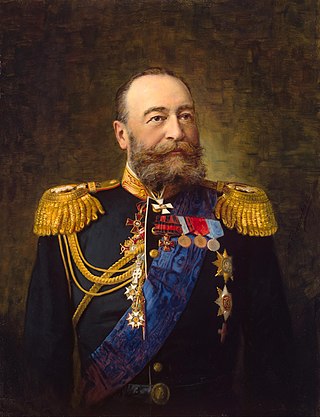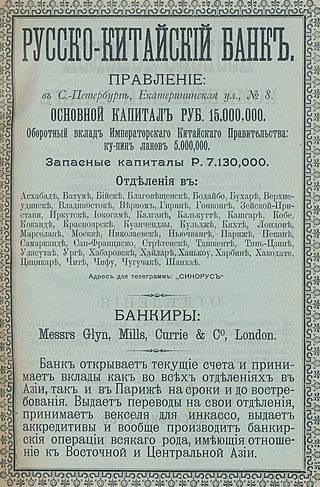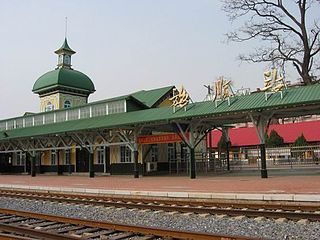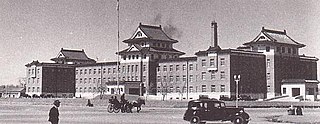
The Treaty of Shimonoseki, also known as the Treaty of Maguan in China and Treaty of Bakan in the period before and during World War II in Japan, was an unequal treaty signed at the Shunpanrō hotel, Shimonoseki, Japan on April 17, 1895, between the Empire of Japan and Qing China, ending the First Sino-Japanese War.

Dalian is a major sub-provincial port city in Liaoning province, People's Republic of China, and is Liaoning's second largest city and the third-most populous city of Northeast China. Located on the southern tip of the Liaodong peninsula, it is the southernmost city in both Liaoning and the entire Northeast. Dalian borders the prefectural cities of Yingkou and Anshan to the north and Dandong to the northeast, and also shares maritime boundaries with Qinhuangdao and Huludao across the Liaodong Bay to west and northwest, Yantai and Weihai on the Shandong peninsula across the Bohai Strait to the south, and North Korea across the Korea Bay to the east.

The South Manchuria Railway, officially The South Manchuria Railway Company, Ltd., Mantetsu or Mantie for short, was a large National Policy Company of the Empire of Japan whose primary function was the operation of railways on the Dalian–Fengtian (Mukden)–Changchun corridor in northeastern China, as well as on several branch lines.

The Liaodong or Liaotung Peninsula is a peninsula in southern Liaoning province in Northeast China, and makes up the southwestern coastal half of the Liaodong region. It is located between the mouths of the Daliao River in the west and the Yalu River in the east, and encompasses the territories of the whole sub-provincial city of Dalian and parts of prefectural cities of Yingkou, Anshan and Dandong.

Lüshunkou District is a district of Dalian, Liaoning province, China. Also formerly called Lüshun City or literally Lüshun Port, it was formerly known as both Port Arthur and Ryojun. The district's area is 512.15 km2 (197.74 sq mi) and its permanent population as of 2010 is 324,773.

Manchuria is a region in East Asia. Depending on the definition of its extent, Manchuria can refer either to a region falling entirely within present-day China, or to a larger region today divided between Northeast China and the Russian Far East. To differentiate between the two parts following the latter definition, the Russian part is also known as Outer Manchuria, while the Chinese part is known as Northeast China.

The Chinese Eastern Railway or CER, is the historical name for a railway system in Northeast China.

The Kwantung Leased Territory was a leased territory of the Empire of Japan in the Liaodong Peninsula from 1905 to 1945.

Northeast China is a geographical region of China, also called Manchuria in history. It usually corresponds specifically to the three provinces east of the Greater Khingan Range, namely Liaoning, Jilin, and Heilongjiang, but historically is meant to also encompass the four easternmost prefectures of Inner Mongolia west of the Greater Khingan. The heartland of the region is the Northeast China Plain, the largest plain in China, with an area of over 350,000 km2 (140,000 sq mi). It is separated from the Russian Far East to the north by the Amur, Argun, and Ussuri Rivers; from Korea to the south by the Yalu and Tumen Rivers; and from Inner Mongolia to the west by the Greater Khingan and parts of the Xiliao River.

Relations between the Empire of Japan and the Russian Empire (1855–1917) were minimal until 1855, mostly friendly from 1855 to the early 1890s, but then turned hostile, largely over the status of Manchuria and of Korea. The two empires established diplomatic and commercial relations from 1855 onwards. The Russian Empire officially ended in 1917, and was succeeded by Communist rule formalized in 1922 with the formation of the Soviet Union.

The Li–Lobanov Treaty or the Sino-Russian Secret Treaty was a secret and unequal treaty signed on June 3, 1896 in Moscow by foreign minister Alexey Lobanov-Rostovsky on behalf of the Russian Empire and viceroy Li Hongzhang on behalf of Qing China. The treaty and its consequences increased anti-foreign sentiment in China, which came to a head in the Boxer Uprising of 1900.

Yevgeni Ivanovich Alekseyev or Alexeyev was a Russian admiral in the Imperial Russian Navy, viceroy of the Russian Far East, and commander-in-chief of Imperial Russian forces at Port Arthur and in Manchuria during the first year of the Russo-Japanese War of 1904-05.

Jinzhou District is one of the seven districts of Dalian, Liaoning province, People's Republic of China. It is located about 20 kilometres (12 mi) northeast of the city centre and faces the Bohai Sea to the west as well as the Korea Bay to the east and has a longer history than Dalian itself, and used to be a thriving walled city where the officials of this area were dispatched from the central government. Recently, it is again a thriving town, having Dalian Development Area within its area as well as becoming a bedroom community to downtown Dalian. Its area is 1,352.54 square kilometres (522.22 sq mi) and its permanent population as of 2010 is 1,102,773.

The Russo-Chinese Bank was a foreign bank, founded in 1895, that represented joint French and Russian interests in China during the late Qing dynasty. It merged in 1910 with the French-sponsored Banque du Nord, a large domestic bank in Russia, to form the Russo-Asiatic Bank.

Lüshun railway station is located in Lüshunkou District of Dalian City, China, and is the final stop of the Dalian-Lushun branch of the Dalian-Harbin railway. It sits on the east side of the Long River, within a hundred meters of the Lüshun Naval Port, its building being of the Russian-style wooden architecture.

The Kwantung Army was a general army of the Imperial Japanese Army from 1919 to 1945.
The Convention for the Lease of the Liaotung Peninsula, also known as the Pavlov Agreement, is an unequal treaty signed between Alexander Pavlov of the Russian Empire and Li Hongzhang of the Qing dynasty of China on 27 March 1898. The treaty granted Russia the lease of Port Arthur (Lüshun) and permitted its railway to extend to the port from one of the points of the Chinese Eastern Railway (CER).

Lüshun Port in Lüshunkou District, Dalian, Liaoning province, China, refers to the original Lüshun Naval Port for military use or the New Lüshun Port for commercial use. The port was known in colonial times as Port Arthur. The Liaonan Shipyard in Lüshun is a major naval shipbuilding centre for the Chinese PLAN.

On 31 December 1952, the Soviet Union returned full control of the Chinese Eastern Railway to the People's Republic of China. The return of the railway marked the first time that the China Eastern Railway had been under full Chinese control since its construction in 1898. The handover of the railway was the result of negotiations between the Soviet Union and the People's Republic of China culminating in the signing of the Sino-Soviet Treaty of Friendship, Alliance and Mutual Assistance. The Friendship Treaty stipulated that the Chinese Changchun Railway (CCR) be handed over to China no later than 31 December 1952. On that date, China received all of the assets of the Chinese Changchun Railway including 3,282.7 kilometers of railway lines, 10,200 railcars, 880 locomotives, power plants, heavy industries, and coal mines as well as houses, medical facilities, and schools. The transfer of this fully operable railway gave the People's Republic of China control over a politically and economically significant rail line. The Chinese Changchun Railway connected the national railway system to the important ports of Dalian, and Lüshun as well as to international border crossings with the Soviet Union and to North Korea.

The Renkyō Line was the primary trunk line of the South Manchuria Railway from 1907 to 1945. The 701.4 km (435.8 mi) line ran between Dalian (Dairen) and Changchun (Xinjing).































